The Intel Optane Memory (SSD) Preview: 32GB of Kaby Lake Caching
by Billy Tallis on April 24, 2017 12:00 PM EST- Posted in
- SSDs
- Storage
- Intel
- PCIe SSD
- SSD Caching
- M.2
- NVMe
- 3D XPoint
- Optane
- Optane Memory
Sequential Read
Sequential access is usually tested with 128kB transfers, which is large enough that requests can typically be striped across multiple controller channels and still involve writing a full page or more to the flash on each channel. Real-world sequential transfer sizes vary widely depending on factors like which application is moving the data or how fragmented the filesystem is.
The drives were preconditioned with two full writes using 4kB random writes, so the data on each drive is entirely fragmented. This may limit how much prefetching of user data the drives can perform on the sequential read tests, but they can likely benefit from better locality of access to their internal mapping tables. These tests were conducted on the Optane Memory as a standalone SSD, not in any caching configuration.
Queue Depth 1
The test of sequential read performance at different transfer sizes was conducted at queue depth 1. Each transfer size was used for four minutes, and the throughput was averaged over the final three minutes of each test segment.
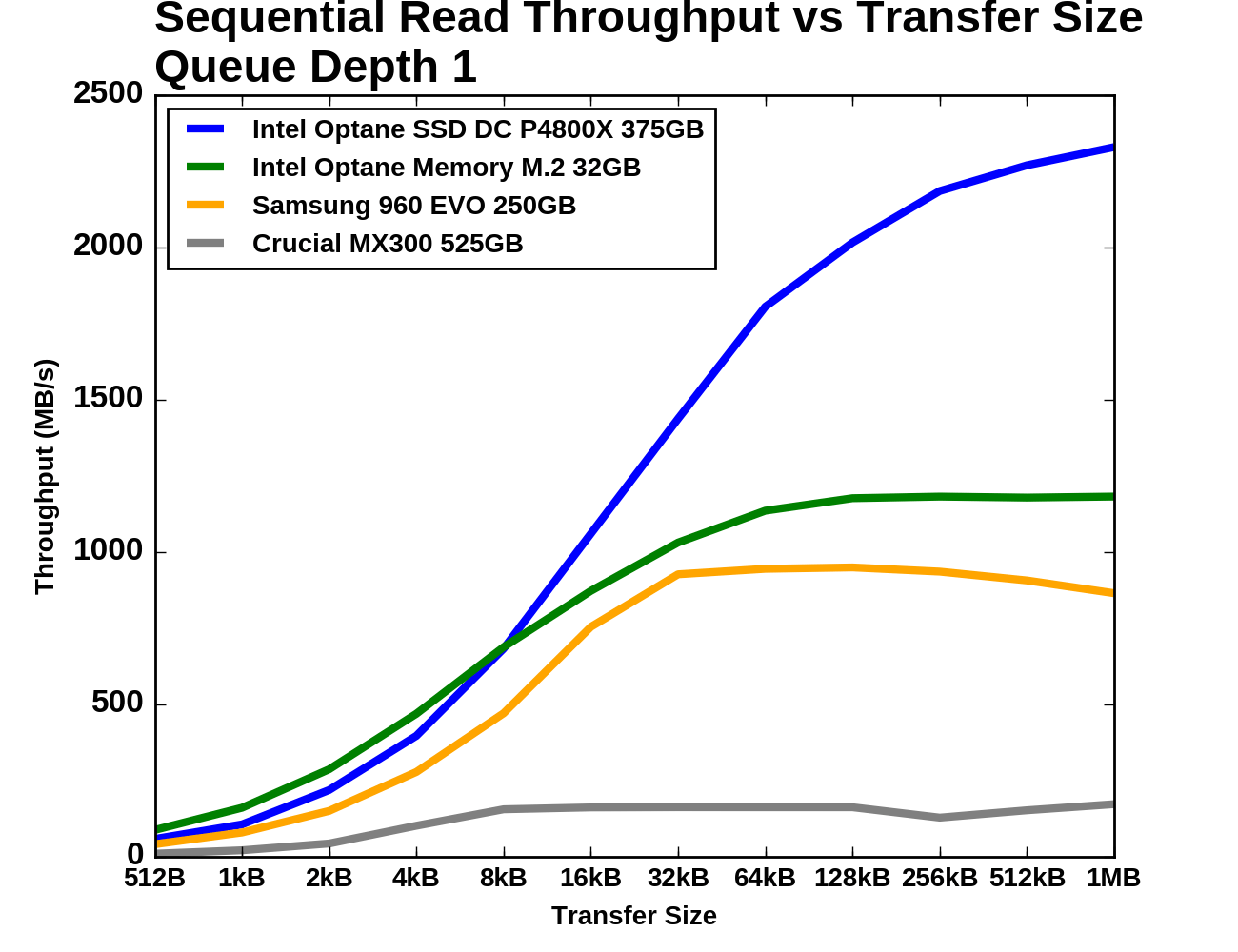 |
|||||||||
| Vertical Axis scale: | Linear | Logarithmic | |||||||
The three PCIe drives show similar growth through the small to mid transfer sizes, but the Optane Memory once again has the highest performance for small transfers and higher performance across the board than the Samsung 960 EVO.
Queue Depth > 1
For testing sequential read speeds at different queue depths, we use the same overall test structure as for random reads: total queue depths of up to 64 are tested using a maximum of four threads. Each thread is reading sequentially but from a different region of the drive, so the read commands the drive receives are not entirely sorted by logical block address.
The Samsung 960 EVO and Optane Memory start out with QD1 sequential read performance and latency that is relatively close, but then at higher queue depths the Optane Memory jumps up to a significantly higher throughput.
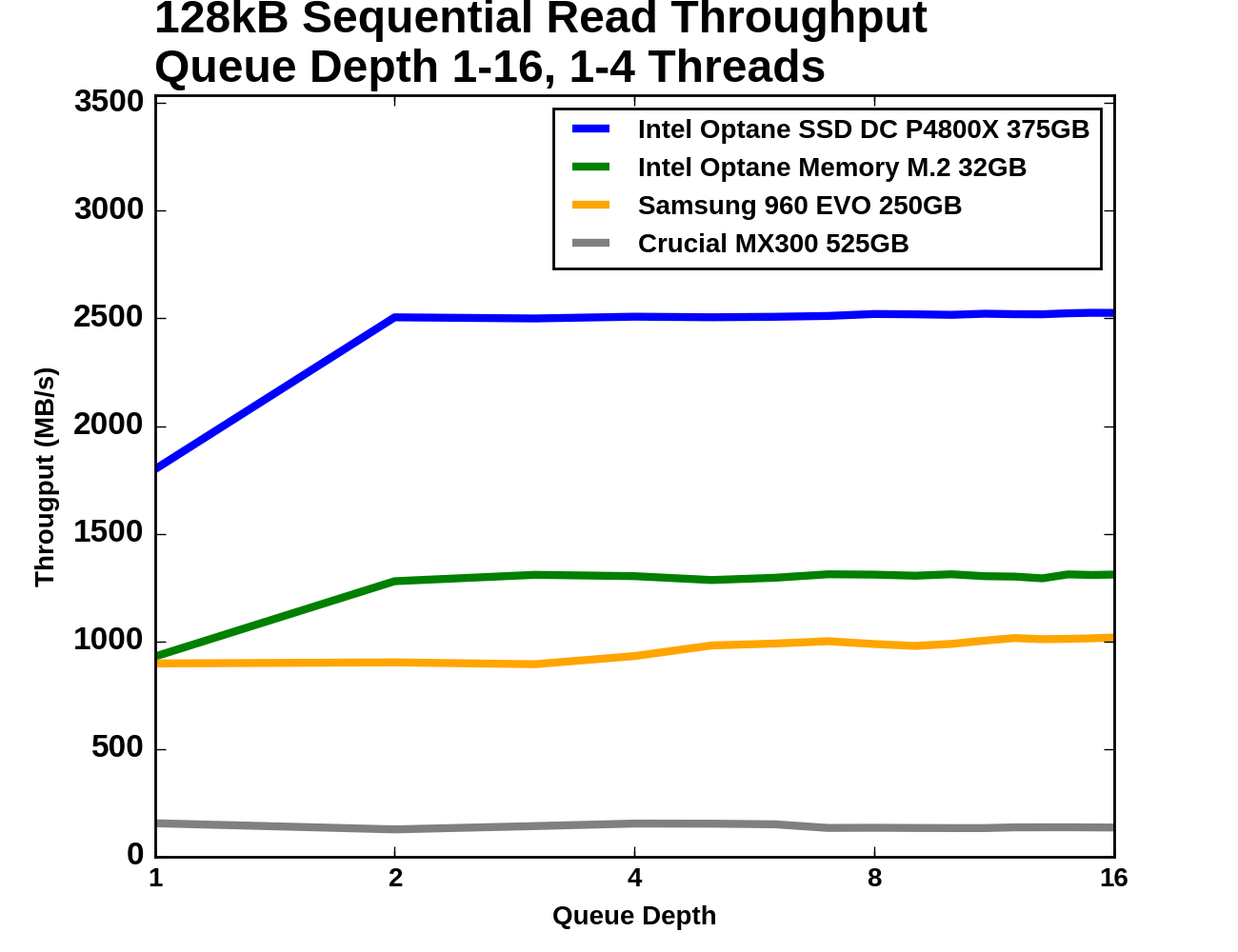 |
|||||||||
| Vertical Axis scale: | Linear | Logarithmic | |||||||
The two Optane devices saturate for sequential reads at QD2, but the Optane Memory experiences a much smaller jump from its QD1 throughput. The flash SSDs are mostly saturated from the start. The Crucial MX300 delivers far lower performance than SATA allows for, due to this test being multithreaded with up to four workers reading from different parts of the drive.
 |
|||||||||
| Mean | Median | 99th Percentile | 99.999th Percentile | ||||||
Since all four drives are saturated through almost all of this test, the latency graphs are fairly boring: increasing queue depth increases latency. For mean and median latency the Optane Memory and the Samsung 960 EVO are relatively close, but for the 99th and 99.999th percentile metrics the 960 EVO is mostly slower than the Optane Memory by about the same factor of two that the P4800X beats the Optane Memory by.
Sequential Write
The sequential write tests are structured identically to the sequential read tests save for the direction the data is flowing. The sequential write performance of different transfer sizes is conducted with a single thread operating at queue depth 1. For testing a range of queue depths, a 128kB transfer size is used and up to four worker threads are used, each writing sequentially but to different portions of the drive. Each sub-test (transfer size or queue depth) is run for four minutes and the performance statistics ignore the first minute. These tests were conducted on the Optane Memory as a standalone SSD, not in any caching configuration.
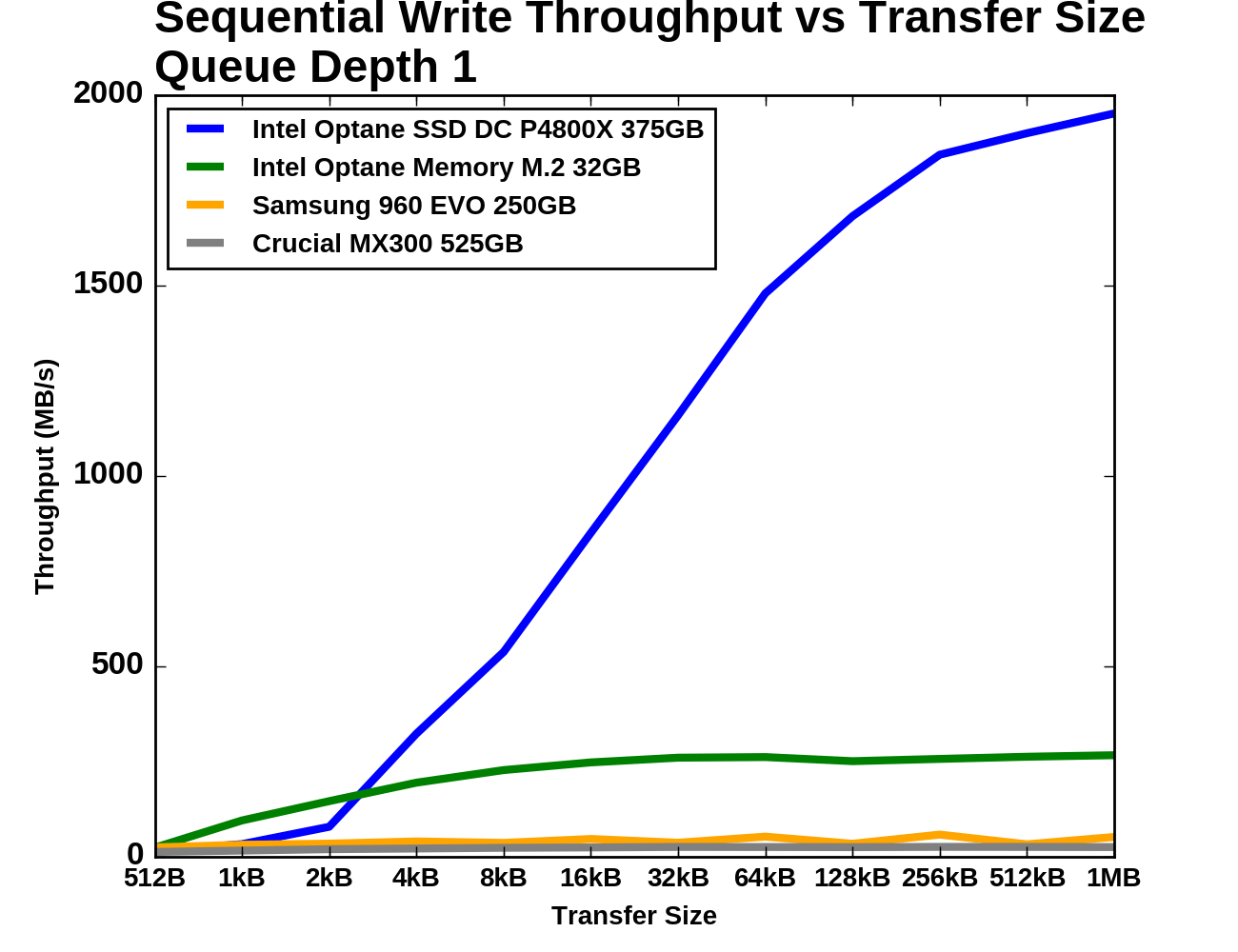 |
|||||||||
| Vertical Axis scale: | Linear | Logarithmic | |||||||
The enterprise-focused Optane SSD P4800X is slower than the consumer Optane Memory for sequential writes of less than 4kB, and even the Samsung 960 EVO beats the P4800X at 512B transfers. The 960 EVO's performance is inconsistent through the second half of the test but on average it is far closer to the MX300 than either Optane device. For larger transfers the MX300 is about a tenth the speed of the Optane Memory.
Queue Depth > 1
The sequential write throughput of the Optane SSD DC P4800X dwarfs that of the other three drives, even the Optane Memory. The Optane Memory does provide substantially higher throughput than the flash SSDs, but it does not have a latency advantage for sequential writes.
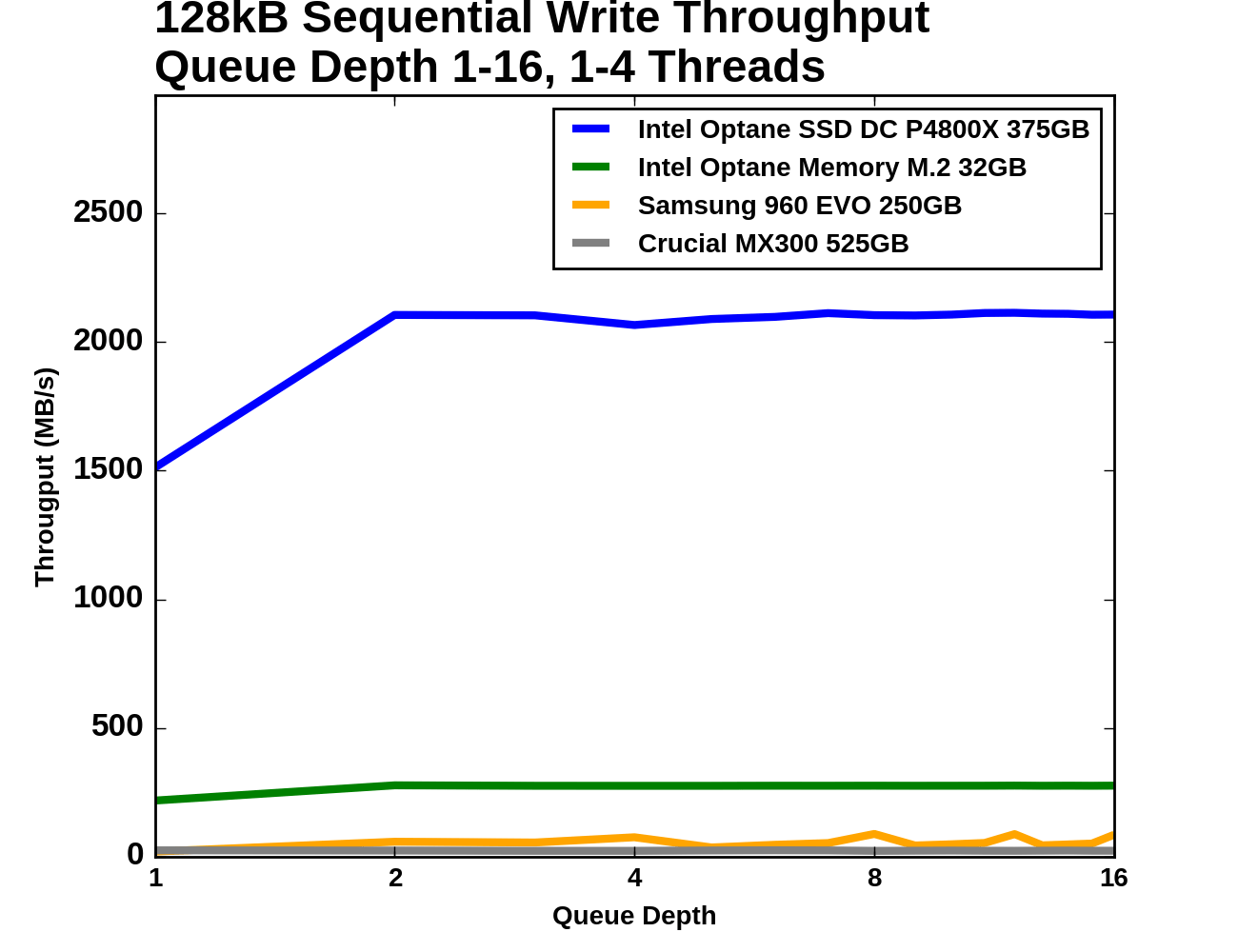 |
|||||||||
| Vertical Axis scale: | Linear | Logarithmic | |||||||
The Crucial MX300 is the only drive that does not get a throughput boost going from QD1 to QD2; as with the random write test it is not able to improve performance when the higher queue depth is due to multiple threads writing to the drive. The Samsung 960 EVO improves from the addition of a second thread but beyond that it simply gets more inconsistent. The Optane Memory and P4800X are both very consistent and saturated at QD2 after a moderate improvement from QD1.
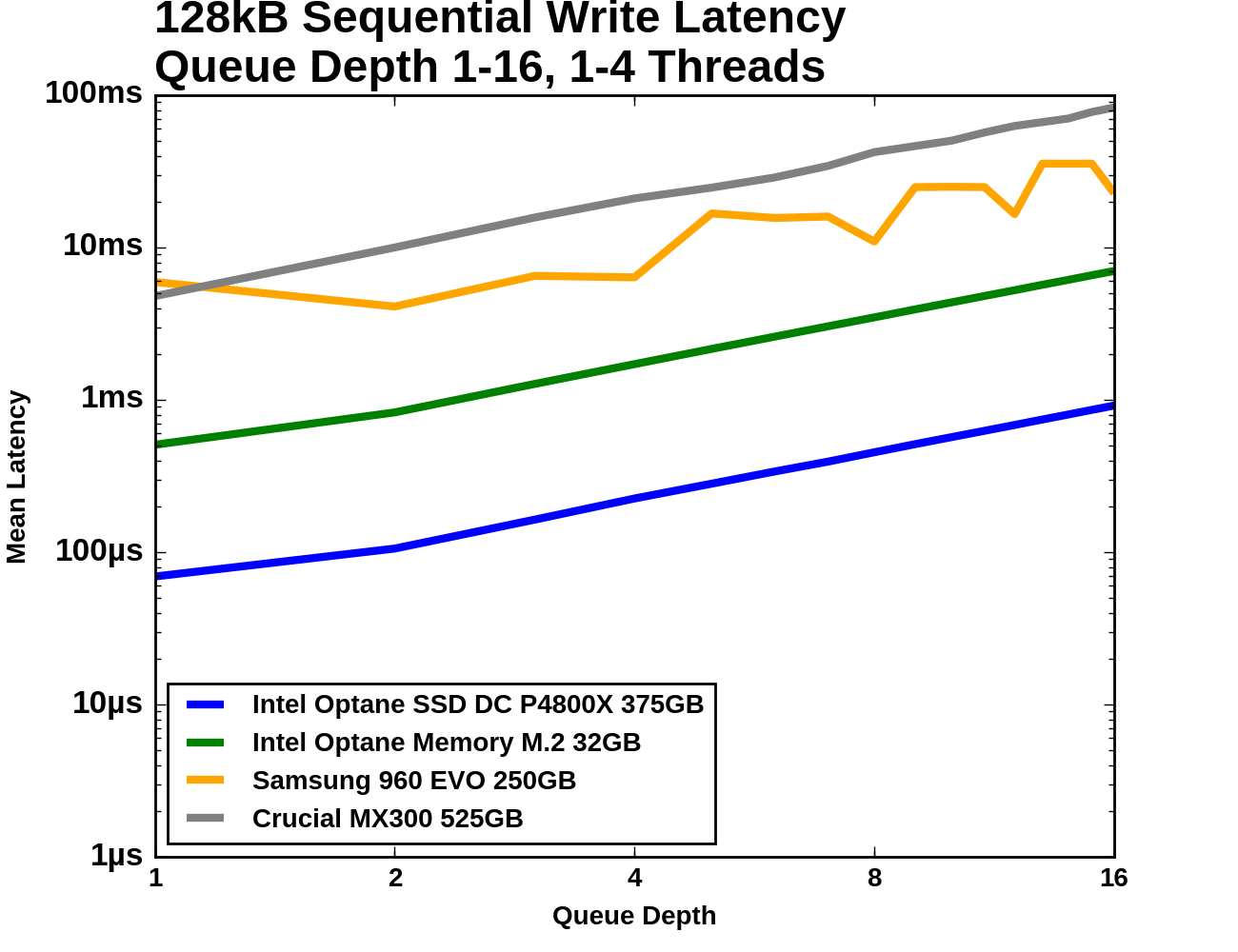 |
|||||||||
| Mean | Median | 99th Percentile | 99.999th Percentile | ||||||
The flash SSDs get more inconsistent with increased thread count and queue depth, but other than that the latency charts show the predictable growth in latency that comes from the drives all being saturated in terms of throughput.












110 Comments
View All Comments
ddriver - Tuesday, April 25, 2017 - link
Yeah, daring intel, the pioneer, taking mankind to better places.Oh wait, that's right, it is actually a greedy monopoly that has mercilessly milked people while making nothing aside from barely incremental stuff for years and through its anti-competitive practices has actually held progress back tremendously.
As I already mentioned above, the last time "intel dared to innovate" that resulted in netburst. Which was so bad that in order to save the day intel had to... do what? Innovate once again? Nope, god forbid, what they did was go back and improve on the good design they had and scrapped in their futile attempts to innovate.
And as I already mentioned above, all the secrecy behind xpoint might be exactly because it is NOTHING innovative, but something old and forgotten, just slightly improved.
Reflex - Tuesday, April 25, 2017 - link
Axe is looking pretty worn down from all that grinding....ddriver - Wednesday, April 26, 2017 - link
Also, unlike you, I don't let personal preferences cloud my objectivity. If a product is good, even if made by the most wretched corporation out there, it is not a bad product just because of who makes it, it is still a good product, still made by a wretched corporation.Even if intel wasn't a lousy bloated lazy greedy monopolist, hypetane would still suck, because it isn't anywhere near the "1000x" improvements they promised. It would suck even if intel was a charity that fed the starving in the 3rd world.
I would have had ZERO objections to hypetane, and also wouldn't call it hypetane to begin with, if intel, the spoiled greedy monopolist was still decent enough to not SHAMELESSLY LIE ABOUT IT.
Had they just said "10x better latency, 4x better low depth queue performance" and stuff like that, I'd be like "well, it's ok, it is faster than nand, you delivered what you promised.
But they didn't. They lied, and lied, and now that it is clear that they lied, they keep on lying and smearing with biased reviews in unrealistic workloads.
What kind of an idiot would ever approve of that?
fallaha56 - Tuesday, April 25, 2017 - link
OMG when our product wasn't as good as we said it was we didn't own-up about itand maybe you test against HDD (like Intel) but the rest of us are already packing SSDs
philehidiot - Saturday, April 29, 2017 - link
This is what companies do. Your technology is useless unless you can market it. And you don't market anything by saying it's mediocre. Look at BP's high octane fuel which supposedly cleans your engine and gets better fuel efficiency. The ONLY thing that higher octane fuel does is resist auto-ignition under compression better and thus certain high performance engines require it. As for cleaning your engine - you're telling me you've got a solvent which is better at cutting through crap than petrol AND can survive the massive temperatures and pressures inside the combustion chamber? It's the petrol which scrubs off the crap so yes, it's technically true. They might throw and additive or two in there but that will only help pre-combustion chamber and if you actually have a problem. And Yes, in certain, newer cars with certain sensors you will get SLIGHTLY higher MPG and therefore they advertise the maximum you'll get under ideal conditions because no one will but into it if you're realistic about the gains. The gains will never offset the extra cost of the fuel, however.PC marketing is exactly the same and why the J Micron controller was such a disaster so many years ago. They went for advertised high sequential throughput numbers being as high as possible and destroyed the random performance, Anand spotted it and OCZ threw a wobbler. But that experience led to drives being advertised on random performance as well as sequential.
So what's the lesson here? We should always take manufacturer's claims with a mouthful of salt and buy based on objective criteria and independent measurements. Manufacturers will always state what is achievable in basically a lab set up with conditions controlled to perfection. Why? Because for one you can't quote numbers based on real life performance because everyone's experience will differ and you can't account for the different variables they'll experience. And for two, if everyone else is quoting the maximum theoretical potential, you're immediately putting yourself at a disadvantage by not doing so yourself. It's not about your product, it's about how well you can sell it to a customer - see: Stupidly expensive Dyson Hairdryer. Provides no real performance benefit over a cheap hairdryer but cost a lot in R&D and is mostly advertising wank for rich people with small brains.
As for Intel being a greedy monopoly... welcome to capitalism. If you don't want that side effect of the system then bugger off to Cuba. Capitalism has brought society to the highest standard of living ever seen on this planet. No other form of economic operation has allowed so many to have so much. But the result is big companies like Intel, Google, Apple, etc, etc.
Advertising wank is just that. Figures to masturbate over. If they didn't do it then sites like Anandtech wouldn't need to exist as products would always be accurately described by the manufacturer and placed honestly within the market and so reviews wouldn't be required.
I doubt they lied completely - they will be going on the theoretical limits of their technology when all engineering limitations are removed. This will never happen in practice and will certainly never happen in a gen 1 product. Also, whilst I see this product as being pointless, it's obviously just a toe dipping exercise like the enterprise model. Small scale, very controlled use cases and therefore good real world use data to be returned for gen 2/3.
Personally, whilst I'm wowed by the figures, I don't see how they're going to improve things for me. So what's the point in a different technology when SLC can probably perform just as well? It's a different development path which will encounter different limitations and as a result will provide different advantages further down the road. Why do they continue to build coal fired power stations when we have CCGTs, wind, solar, nukes, etc? Because each technology has its strengths and weaknesses and encounters different engineering limitations in development. Plus a plurality of different, competing technologies is always better as it creates progress. You can't whinge about monopolies and then when someone starts doing something different and competing with the established norm start whinging about that.
fallaha56 - Tuesday, April 25, 2017 - link
hi @sarah i find that a dead hard drive also plays into responsiveness and boot times(!)this technology is clearly not anywhere near as good as Intel implied it was
CaedenV - Monday, April 24, 2017 - link
I have never once had an SSD fail because it has over-used its flash memory... but controllers die all the time. It seems that this will remain true for this as well.Ryan Smith - Tuesday, April 25, 2017 - link
And that's exactly what we're suspecting here. We've likely managed to hit a bug in the controller's firmware. Which to be sure, isn't fantastic, but it can be fixed.Prior to the P3700's launch, Intel sent us 4 samples specifically for stress testing. We managed to disable every last one of them. However Intel learned from our abuse, and now those same P3700s are rock-solid thanks to better firmware and drivers.
jimjamjamie - Tuesday, April 25, 2017 - link
Interesting that an ad-supported website can stress-test better than a multi-billion dollar company..testbug00 - Tuesday, April 25, 2017 - link
based on what? Have they sent you another model?A sample dying on day one, and only allowing testing via remote server doesn't confidence build.